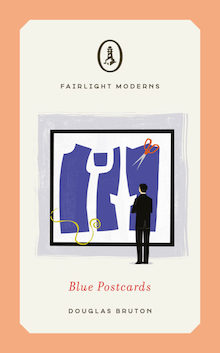Was signing copies of Blue Postcards in the window of Portobello Bookshop yesterday morning. Thanks to Alice and the rest of the staff who made me feel so welcome. If you are in the area (or maybe go out of your way a little) this is a great bookshop with very interesting stock. I can never get out of the shop without a bundle of books under my arm (paid for of course). Here's a pic - nice window to sit in btw.
Saturday 9 October 2021
Monday 4 October 2021
Nice review up on 'NECESSARY FICTION'
Blue Postcards by Douglas Bruton
Blue Postcards, a novella by Douglas Bruton, is at once song, poem, and scripture, and it is woven as tightly and expertly as the twisted tekhelet threads in a Jewish prayer shawl’s four tassels. Tekhelet, it is important to know, is an ancient blue-violet dye whose precise means of manufacture have been lost to time. The word is translated in various ways, perhaps most descriptively as the color of the sky.
Bruton swathes Blue Postcards, in every imaginable shade of blue, beginning with the opening sentence:
At the foot of the steps of Le Passage de la Sorcière in Montmartre sits a man in a blue suit, the sleeves of his jacket pushed up to his elbows, his shirt collar unfastened and his blue tie loose around his neck.
The word blue appears 655 times in the novella’s 500 numbered paragraphs. Throughout, Bruton refers not only to sky blue, but also to lapis blue, ultramarine blue, cobalt blue, the blue of ink stains, of gaslight, of the sea running shallow over white sand or stone, blue ribbons, a blue fluted Royal Copenhagen cup, blue willow pattern china, blue twenty-euro notes, blue judo belts, blue eyes, a blue sock, the blue wings of a swallow, a tailor’s blue chalk, blue feathers, blue periods in art, blue-black bruises, and, of course, blue postcards.
The story begins with a chance meeting between two of Blue Postcards’ main characters: the unnamed narrator, an older man, and a young woman named Michelle, from whom he purchases a blue postcard. The narrator returns repeatedly to Michelle’s shop in search of these cards, which he knows are the work of Yves Klein, a postwar painter who is still noted for his monochromatic canvases as well as for a particular shade of blue he invented, International Klein Blue. In the course of his visits, the narrator becomes infatuated with Michelle. Bruton adds a third character, Henri, a Jewish tailor and survivor of the Nazi genocide who coincidentally fits Yves Klein for a suit.
As the characters’ stories run together, the more untrustworthy the narrator becomes — for, whoever he is, he is full of lies. Blue lies, to be precise. As he tells us:
None of these stories are to be trusted, for they are stories of the dead told by the living and the living always lie, white and blue lies. A ‘blue lie’ is a lie told for the collective good. Stories of saints and their miracles may be thought of as blue lies. Like white lies they mean no harm.
Bruton’s narrator means no harm. He tells his lies as he tells stories of his youth and of his present, embellishing everything until even he no longer recognizes what is true and what is imagined, all for the sake of the story.
Time in this novel is fluid; the story is told in every character’s present — yet the present is not fixed. The narrator speaks sometimes with the voice of his older self and at other times with that of his youth. The trickster hints that the memories may not be memories but imagination:
If things are a little out of time maybe it has something to do with the direction of time’s arrow, which in fiction can be flighted with an angel’s feathers – blue and white – and does not need to travel forward but can flip backwards if it must. Memory is like that, too.
Blue Postcards can and should be read multiple times, as readers will discover more about the story with each reading. The narrator himself invites multiple readings: “Like the swallows that return each year, so will the reader to the pages, again and again.”
+++
+

